K92 Mining Declares Maiden Inferred Resource of 10.8 Million oz AuEq or 4.7 Billion lbs CuEq at the Blue Lake Porphyry
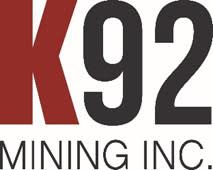
Figure 1

Figure 2
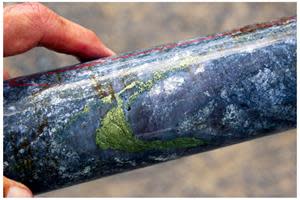
Figure 3

Figure 4
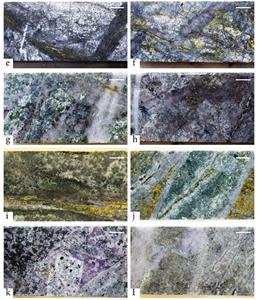
Figure 5
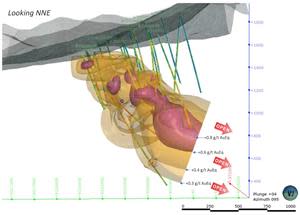
Figure 6
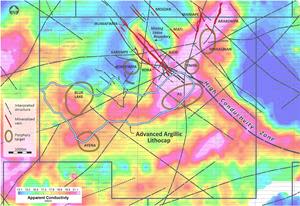
VANCOUVER, British Columbia, Aug. 09, 2022 (GLOBE NEWSWIRE) -- K92 Mining Inc. (“K92” or the “Company”) (TSX: KNT; OTCQB: KNTNF) is pleased to announce a maiden resource estimate at the Blue Lake porphyry project, located approximately 4 km southwest of the Company’s producing high-grade gold-copper Kora and Judd intrusion-related deposits at the Kainantu Gold Mine in Papua New Guinea. Blue Lake was discovered by K92 after mineralized lithocap was identified in 2017. K92 has completed two diamond drill programs for a total of 26 holes and 16,474.8 metres at the project.
Blue Lake Gold-Copper Porphyry Maiden Mineral Resource Estimate Highlights
Significant maiden inferred resource estimate declared of 10.8 million ounces gold equivalent (“AuEq”) at 0.61 g/t AuEq or 4.7 billion lbs CuEq at 0.38% CuEq, based on 549 million tonnes at 0.21 g/t Au, 0.23% Cu and 2.42 g/t Ag at a 0.4 g/t AuEq cut-off grade.
Extensive potential for resource growth as Blue Lake is open at depth, with significant potential for expansion and delineation of the high-grade potassic core (see Figure 5). The Blue Lake porphyry has approximately equal ratios of gold and copper.
Future exploration plans at Blue Lake include drilling to target expanding the higher-grade core which is open at depth, and exploring for additional mineralized porphyries beneath an extensive composite lithocap that extends to and includes the A1 Porphyry Target (See Figure 5 & 6).
Porphyry exploration is advancing at the A1 Porphyry Target, our highest priority porphyry target based on geophysics completed in late-2021, with an initial soils, rock chip sampling and detailed mapping program commencing shortly, followed by drilling.
Table 1 – Blue Lake Mineral Resource (Effective Date August 1, 2022, 0.4 g/t AuEq cut-off)
AuEq | Mt | Au | Cu | Ag | AuEq | CuEq | Au | Cu | Ag | AuEq | CuEq |
Inferred | 549 | 0.21 | 0.23 | 2.42 | 0.61 | 0.38 | 3.7 | 1.3 | 43 | 10.8 | 4.7 |
|
|
|
|
|
|
|
|
|
|
|
|
Estimates are based on Technical Report titled, “Independent Technical Report, Mineral Resource Estimate Blue Lake Porphyry, Kainantu Project, Papua New Guinea”.
The Independent and Qualified Person responsible for the mineral resource estimate is Simon Tear, P.Geo. of H & S Consultants Pty. Ltd., Sydney, Australia, and the effective date of the Mineral Resource is August 1, 2022.
Mineral resources are not mineral reserves and do not have demonstrated economic viability.
Resources were compiled at 0.1, 0.2, 0.3, 0.4, 0.5, 0.6 g/t AuEq cut-off grades.
Density was based on 2,473 measured density data recordings (weighed core trays and measured core) which were composited and subsequently modelled unconstrained using Ordinary Kriging. Reported tonnage and grade figures are rounded from raw estimates to reflect the order of accuracy of the estimate.
Minor variations may occur during the addition of rounded numbers.
Estimations used metric units (metres, tonnes and g/t)
Gold equivalents are calculated as AuEq = Au g/t + Cu%*1.607 + Ag g/t*0.0125. Copper equivalents are calculated as CuEq = Cu% + Au g/t*0.006222 + Ag g/t* 0.00007778. Gold price US$1,600/oz; Silver US$20/oz; Copper US$3.75/lb.
Table 2 – Blue Lake Porphyry Resource at various cut-off grades.
(Resource Estimate is for 0.4 g/t AuEq cut-off; tabulation of other cut-off values for information only)
AuEq | Mt | Au | Cu | Ag | AuEq | CuEq | Au | Cu | Ag | AuEq | CuEq |
0.1 | 1,247 | 0.13 | 0.16 | 2.17 | 0.41 | 0.26 | 5.2 | 2.0 | 87 | 16.4 | 7.1 |
0.2 | 1,080 | 0.15 | 0.17 | 2.28 | 0.45 | 0.28 | 5.2 | 1.8 | 79 | 15.6 | 6.6 |
0.3 | 808 | 0.18 | 0.20 | 2.43 | 0.52 | 0.33 | 4.7 | 1.6 | 63 | 13.5 | 5.9 |
0.4 | 549 | 0.21 | 0.23 | 2.42 | 0.61 | 0.38 | 3.7 | 1.3 | 43 | 10.8 | 4.7 |
0.5 | 382 | 0.25 | 0.25 | 2.39 | 0.68 | 0.42 | 3.1 | 1.0 | 29 | 8.3 | 3.7 |
0.6 | 233 | 0.30 | 0.28 | 2.43 | 0.77 | 0.49 | 2.2 | 0.7 | 18 | 5.8 | 2.6 |
Chris Muller, K92 Vice President Exploration, stated, “We are delighted to announce a maiden mineral resource for the Blue Lake Porphyry, after the initial discovery by K92 Mining in 2017. The Blue Lake Porphyry is evidently a very large, well-mineralized system, with a number of overprinting events that have introduced gold and copper. In particular, those which are manifested as quartz stockwork veins and bornite mineralization will be the focus of ongoing drill targeting at Blue Lake. A very expansive silica-clay lithocap connecting Blue Lake with the A1 Prospect is virtually untested by drilling and has the potential to host multiple gold-copper mineralized porphyries.
This resource declaration is the fifth largest known mineralized porphyry in Papua New Guinea in terms of pre-mined contained gold equivalent ounces, after the world famous Golpu, Panguna, Ok Tedi and Frieda River porphyry deposits.
It is truly remarkable to be able to look down upon the Lae-Madang Highway, a major transport route to the Lae International Port, while standing on an outcropping undeveloped resource containing in excess of 10 million gold equivalent ounces, and as much as 15 million ounces using a lower cut-off grade.”
John Lewins, K92 CEO and Director, added, “The maiden resource estimate at Blue Lake is a major accomplishment, defining a large-scale, potentially commerical gold-copper porphyry proximal to our high-grade Kainantu underground mine. Blue Lake was also defined efficiently, leveraging our team’s extensive exploration experience in Papua New Guinea, with nearly all holes intersecting mineralization and only 16,475 metres of drilling to define 10.8 million ounces AuEq or 4.7 billion lbs CuEq of inferred resource – implying an average discovery rate of aproximately 650 oz AuEq per metre drilled.
Importantly, we believe Blue Lake is only the tip of the porphyry iceberg at Kainantu and have gained a tremendous amount of knowledge for our porphyry exploration programs going forward. In Papua New Guinea, porphyries tend to cluster and there are five other porphyry targets proximal to Blue Lake, with A1 being of the highest priority. Soil sampling at A1 is expected to commence imminently, with diamond drilling planned afterwards. Between our intrusion related gold/copper exploration at Kora, Judd, Kora South and Judd South and our porphyry exploration, we are very excited about the potential at Kainantu.”
Deposit Geology
The Blue Lake Porphyry Project is located approximately 4 km southwest of the Company’s producing high-grade Kora and Judd intrusion-related gold-copper deposits at the Kainantu Gold Mine. Drilling at Blue Lake has defined a large tonalite porphyry stock, comprising multiple overprinting intrusives, that are variably mineralized with gold and copper. The highest grades are associated with a potassic alteration core, characterized by biotite, K-feldspar and chalcopyrite/bornite mineralization, with a propensity of quartz stockwork veins. Cu/Au mineralization is approximately at a 1:1 ratio, that is open to the south-west.
See Figure 1 – Location of the Blue Lake Porphyry
https://www.globenewswire.com/NewsRoom/AttachmentNg/ccf224d8-7181-443d-bd1e-8e38c782cab4
The mineralized porphyry is concentrically zoned and tilted towards the north-west. This zonation is apparent both in metal (sulphide) distribution, with bornite grading into chalcopyrite with a molybdenum periphery, and finally into pyrite, as well as in alteration mineral assemblages, with biotite-K feldspar giving way peripherally to epidote-albite through a transitional actinolite zone. The prograde assemblages have been largely overprinted by intense sericite-pyrite alteration. There is a prominent silica-clay cap, characterized by dominant pyrophyllite, with alunite feeder zones.
Blue Lake Exploration Background
The Blue Lake Porphyry Project was initially recognized in early February 2017, when three small hand specimens were shown by a landowner to K92’s VP Exploration. These comprised intensely altered breccia and dacite, with pyrophyllite altered clasts or leached phenocrysts, respectively, and immediately attracted our attention. When questioned as to their origin, the landowner pointed towards the mountains and said it was from ‘Blue Lake’.
The Blue Lake Porphyry was later discovered in outcrop, during reconnaissance by K92 in May 2017, after which a large (1.5 x 0.8 km) coincident Au-Cu soil geochemical anomaly was defined from soil sampling. The maiden drill hole, KTDD0001, drilled in January 2019, intersected porphyry mineralization, yielding an open-ended 174.6m at 0.64 g/t AuEq (0.28 g/t Au, 0.22 % Cu), from 259.3m. This hole formed part of an initial six-hole program (excluding three short 50m holes and a failed hole at 106m), with hole depths of 400 – 600m depth. The holes were drilled as a fence across the prospect, through the centre of the primary geochemical anomaly, on 200m centres. This program enabled the compilation of an alteration and grade shell model, together with intrusive lithologies and structure, to identify vectors towards mineralization and successfully target the porphyry core.
A second phase of drilling commenced in November 2020, following an eleven-month hiatus (extended significantly by revised, restricting field protocols associated with COVID-19). During this campaign, a 200-metre spaced grid was drilled over the Blue Lake Porphyry, with some additional deeper, targeted holes drilled. 16 holes were drilled in this phase, for a total of 13,048.30 metres, with multiple long intervals of significant gold-copper mineralization yielded, including 200.16m at 1.00 AuEq (0.51 g/t Au, 0.28 % Cu) from 695.84m in hole KTDD0018.
Figure 2 – Blue Lake Hole KTDD0018, 845m.
https://www.globenewswire.com/NewsRoom/AttachmentNg/212ab6aa-11a4-4582-801a-ab1fc98e41cd
Figure 3 - Blue Lake Porphyry drill core from KTDD0018
https://www.globenewswire.com/NewsRoom/AttachmentNg/f8a8a5d3-2e24-4841-bf2b-2d1ba049fbd9
Figure 4 - Blue Lake mineralogy in drill core from holes KTDD0013 and KTDD0018
https://www.globenewswire.com/NewsRoom/AttachmentNg/fe85c547-ab7d-4a81-8a0b-7ce92e2789bd
Key Assumptions and Parameters
K92 engaged independent consulting geologists H&S Consultants Pty Ltd (H&SC) to complete a resource estimate for the Blue Lake gold-copper deposit. The Blue Lake Porphyry Project estimate is based on data and assays from 26 diamond core drill holes at Blue Lake, for a total of 16,474.8 metres.
The drillhole assay data comprised 1m sample intervals. For grade interpolation the complete drilling dataset was composited to 2m for gold, copper silver and a gold equivalent and subsequently modelled. The unconstrained 2m compositing produced a total of 8,141 composites. The gold equivalent value was based on K92’s work at the nearby Kora deposit which used the formula:
AuEq = Au g/t + (Cu% * 1.607) + (Ag ppm * 0.0125)
The geological interpretation was supplied by K92 as a series of 3D wireframes created using Leapfrog software, this included lithologies, faulting, alteration and percentage quartz veining. A detailed topographic surface was also supplied. All data was converted to an H&SC N-S orthogonal local grid for ease of working.
The interpreted porphyry body and its associated mineralization has overall dimensions of 1500m (X) by 1300m (y) by 1100m (Z) with a modest plunge to grid south-east. Mineralization is close to surface (1950mRL approx.) in the grid west and is open at depth. The Mineral Resource is terminated by a notional-pit outline down to 500m RL. Drillhole spacing was nominally on 100m centres in the centre of the deposit extending to 200m in the periphery.
Grade interpolation used Ordinary Kriging for a block size of 25m by 25m by 25m with no sub-blocking. The upper (lithocap) and lower (porphyry) mineral zones were treated separately with regards to the variography, but similar search ellipses were employed with a soft boundary between the zones. Each element was modelled separately, although there is some form of zoned correlation between gold and copper for the lower higher grade porphyry zone.
The density data was composited to 4m giving 1,879 data points which were subsequently modelled unconstrained using Ordinary Kriging, using similar search parameters and rotations to the global metal grade interpolation. Density showed a marked segregation between the upper lithocap dominated zone and the lower altered tonalite zone.
See Figure 5 – Blue Lake Porphyry – Section, viewed north-north-east. Drill holes showing downhole gold and copper grades and distribution of mineralization.
https://www.globenewswire.com/NewsRoom/AttachmentNg/dce3ce8e-6d11-4cc7-bbc9-3bdf1e9acc52
Future program
As with most fertile porphyry environments, e.g., Golpu and Oyu Tolgoi, there is likely a cluster of porphyries in the Blue Lake prospect area, with our exploration work to date supporting this, including:
Advanced argillic alteration covering a vast area over 5 km in length, from Blue Lake to the A1 target.
Locally, the roots of the lithocap remain in situ (dominated by pyrophyllite, typically present deep in lithocaps and nearest to porphyry mineralization) at Blue Lake and the Ayena and A1 targets.
Advanced Mobile MT (magnetotelluric) geophysics completed in late-2021 has outlined several high conductivity targets coincident with mapped silicification.
Evidence of a much larger paleo-lithocap, likely formed by copious porphyry activity, is presented in the high proportion of ubiquitous silicified float (boulders) that fills the drainages and colluvium deposits for 20 km all the way to the Markham River.
Based on the exploration work to date, Blue Lake is proximal to five other porphyry exploration targets: A1, Kokofimpa, Ayena, Timpa and Tankaunan. After the completion of the advanced Mobile MT geophysics in late-2021, A1 is our top porphyry exploration target, driven by having the strongest geophysical conductivity signature, preserved lithocap and situated in a highly prospective environment, at the confluence of the Kora-Kora South, Judd-Judd South structures and the Maniape and Arakompa structures, which both host high-grade intrusion related gold/copper deposits. With the latest program at Blue Lake completed, exploration work on A1 is commencing shortly, including a soil sampling program, detailed mapping and trenching, followed by diamond drilling.
Blue Lake remains open along strike and down plunge. Additionally, with a higher grade core, it is possible that the mineralization is much more extensive than we currently understand and higher grades may be expected in the deeper parts of the system. Drilling plans to target the definition and expansion of the zone of quartz stockwork veins and bornite mineralization within the potassic core.
Figure 6: Airborne Geophysics Mobile MT (apparent conductivity) geophysics plan map proximal to the Blue Lake Porphyry outlining a cluster of nearby porphyry targets and an extensive argillic lithocap with additional porphyry potential underneath.
https://www.globenewswire.com/NewsRoom/AttachmentNg/d71dfeef-73cb-407c-8633-1442fd304b97
Qualified Persons
K92 Vice President Exploration, Mr. Chris Muller, PGeo, a Qualified Person under the meaning of National Instrument 43-101 – Standards of Disclosure for Mineral Projects ("NI 43-101"), has reviewed and is responsible for the technical content of this news release. Data verification by Mr. Muller includes significant time onsite reviewing drill core, soil and outcrop sampling, artisanal workings, as well as discussing work programs and results with geology personnel and external consultants.
Simon Tear, P.Geo EurGeol of H & S Consultants Pty. Ltd. of Sydney, Australia, is the Qualified Person as defined under NI 43-101 for the Blue Lake maiden Mineral Resource. Mr. Tear has reviewed and approved the contents of this press release.
About K92 Mining
K92 Mining Inc. is engaged in the production of gold, copper and silver from the Kora deposit at the Kainantu Gold Mine in the Eastern Highlands province of Papua New Guinea, as well as exploration and development of mineral deposits in the immediate vicinity of the mine. The Company declared commercial production from Kainantu in February 2018 and is in a strong financial position.
The Company commenced an expansion of the mine based on an updated Preliminary Economic Assessment on the property which was published in January 2019 and updated in July 2020. K92 is operated by a team of mining company professionals with extensive international mine-building and operational experience.
On Behalf of the Company,
John Lewins, Chief Executive Officer and Director
For further information, please contact David Medilek, P.Eng., CFA at +1-604-416-4445
CAUTIONARY STATEMENT REGARDING FORWARD-LOOKING INFORMATION: This news release includes certain “forward-looking statements” under applicable Canadian securities legislation. All statements in this news release that address events or developments that we expect to occur in the future are forward-looking statements. Forward-looking statements are statements that are not historical facts and are generally, although not always, identified by words such as “expect”, “plan”, “anticipate”, “project”, “target”, “potential”, “schedule”, “forecast”, “budget”, “estimate”, “intend” or “believe” and similar expressions or their negative connotations, or that events or conditions “will”, “would”, “may”, “could”, “should” or “might” occur. All such forward-looking statements are based on the opinions and estimates of management as of the date such statements are made. Forward-looking statements are necessarily based on estimates and assumptions that are inherently subject to known and unknown risks, uncertainties and other factors, many of which are beyond our ability to control, that may cause our actual results, level of activity, performance or achievements to be materially different from those expressed or implied by such forward-looking information. Such factors include, without limitation, Public Health Crises, including the COVID-19 Pandemic; changes in the price of gold, silver, copper and other metals in the world markets; fluctuations in the price and availability of infrastructure and energy and other commodities; fluctuations in foreign currency exchange rates; volatility in price of our common shares; inherent risks associated with the mining industry, including problems related to weather and climate in remote areas in which certain of the Company’s operations are located; failure to achieve production, cost and other estimates; risks and uncertainties associated with exploration and development; the fact that a feasibility studying of mineral reserves demonstrating economic and technical viability has not been prepared for the Kainantu Mine; uncertainties relating to estimates of mineral resources including uncertainty that mineral resources may never be converted into mineral reserves; the Company’s ability to carry on current and future operations, including development and exploration activities; the timing, extent, duration and economic viability of such operations, including any mineral resources or reserves identified thereby; the accuracy and reliability of estimates, projections, forecasts, studies and assessments; the Company’s ability to meet or achieve estimates, projections and forecasts; the availability and cost of inputs; the price and market for outputs, including gold, silver and copper; inability of the Company to identify appropriate acquisition targets or complete desirable acquisitions; failures of information systems or information security threats; political, economic and other risks associated with the Company’s foreign operations; geopolitical events and other uncertainties, such as the conflict in Ukraine; compliance with various laws and regulatory requirements to which the Company is subject to, including taxation; the ability to obtain timely financing on reasonable terms when required; the current and future social, economic and political conditions, including relationship with the communities in jurisdictions it operates; other assumptions and factors generally associated with the mining industry; and the risks, uncertainties and other factors referred to in the Company’s Annual Information Form under the heading “Risk Factors”. Estimates of mineral resources are also forward-looking statements because they constitute projections, based on certain estimates and assumptions, regarding the amount of minerals that may be encountered in the future and/or the anticipated economics of production, should mining occur. Forward-looking statements are not a guarantee of future performance, and actual results and future events could materially differ from those anticipated in such statements. Although we have attempted to identify important factors that could cause actual results to differ materially from those contained in the forward-looking statements, there may be other factors that cause actual results to differ materially from those that are anticipated, estimated, or intended. There can be no assurance that such statements will prove to be accurate, as actual results and future events could differ materially from those anticipated in such statements. Accordingly, readers should not place undue reliance on forward-looking statements. The Company disclaims any intention or obligation to update or revise any forward-looking statements, whether as a result of new information, future events or otherwise, except as required by law.
CAUTIONARY NOTE TO U.S. READERS CONCERNING ESTIMATES OF MINERAL RESERVES AND MINERAL RESOURCES
Information concerning the properties and operations of K92 has been prepared in accordance with Canadian standards under applicable Canadian securities laws and may not be comparable to similar information for United States companies. The terms “Mineral Resource”, “Measured Mineral Resource”, “Indicated Mineral Resource” and “Inferred Mineral Resource” used in this news release are Canadian mining terms as defined in the Definition Standards for Mineral Resources and Mineral Reserves adopted by the Canadian Institute of Mining, Metallurgy and Petroleum (“CIM”) on May 10, 2014 and incorporated by reference in National Instrument 43-101 – Standards of Disclosure for Mineral Projects (“NI 43-101”). While the terms “Mineral Resource”, “Measured Mineral Resource”, “Indicated Mineral Resource” and “Inferred Mineral Resource” are recognized and required by Canadian securities regulations, they are not defined terms under standards of the United States Securities and Exchange Commission (“SEC”). As such, certain information contained in this news release concerning descriptions of mineralization and resources under Canadian standards is not comparable to similar information made public by United States companies subject to the reporting and disclosure requirements of the SEC. An “Inferred Mineral Resource” has a great amount of uncertainty as to its existence and as to its economic and legal feasibility. Under Canadian rules, estimates of Inferred Mineral Resources may not form the basis of feasibility or pre-feasibility studies. It cannot be assumed that all or any part of an “Inferred Mineral Resource” will ever be upgraded to a higher confidence category through additional exploration drilling and technical evaluation. Readers are cautioned not to assume that all or any part of an “Inferred Mineral Resource” exists or is economically or legally mineable. Under United States standards, mineralization may not be classified as a “Reserve” unless the determination has been made that the mineralization could be economically and legally produced or extracted at the time the Reserve estimation is made. Readers are cautioned not to assume that all or any part of the Measured or Indicated Mineral Resources will ever be converted into Mineral Reserves. In addition, the definitions of “Proven Mineral Reserves” and “Probable Mineral Reserves” under CIM standards differ from the standards of the SEC. Historical results or feasibility models presented herein are not guarantees or expectations of future performance.


 Yahoo Finance
Yahoo Finance 